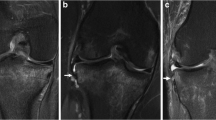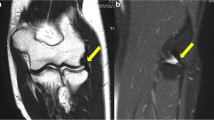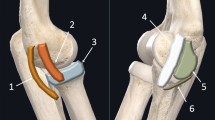Abstract
Objectives
To determine the performances of clinical examination, ultrasonography, and MRI for diagnosing non-displaced and displaced ulnar collateral ligament (UCL) tears.
Methods
Based on a literature search of Medline, ISI Web of Science, Embase, and Scopus between January 1990 and December 2019, all published original articles which met the inclusion criteria were included. We determined the pooled sensitivities, specificities, and accuracies of clinical examination, ultrasonography, and MRI using a meta-analysis based on the Preferred Reporting Items for Systematic Reviews and Meta-Analyses–Diagnostic Test Accuracy (PRISMA-DTA) guidelines.
Results
A total of 17 studies with 519 subjects reporting diagnostic performances of clinical examination (8), ultrasonography (12), and MRI (5) met the inclusion criteria. For ruling out UCL tears, the pooled sensitivities were similarly high for clinical examination (97% (95% confidence interval [CI], 93–99%)), ultrasonography (96% (95% CI, 94–98%)), and MRI (99% (95% CI, 92–100%)) (p = 0.3). For ruling in UCL tears, the pooled specificities were higher for MRI (100% (95% CI, 87–100%)) when compared to ultrasonography (91% (95% CI, 86–95%)) (p = 0.1) and clinical examination (85% (95% CI, 78–91%)) (p = 0.04). For the diagnosis of displaced UCL tears, MRI had a higher specificity (92% (95% CI, 73–99%)) than ultrasonography (72% (95% CI, 63–80%)) (p = 0.2).
Conclusions
Clinical examination, ultrasonography, and MRI have similarly high sensitivities for ruling out UCL tears in patients presenting with a thumb injury. MRI and ultrasonography have high specificities to confirm the presence of suspected UCL tears. MRI performs best for differentiating non-displaced from displaced UCL tears.
Key Points
• Clinical examination followed by ultrasonography is the most appropriate test for ruling out ulnar collateral ligament (UCL) tears of the thumb.
• MRI and ultrasonography both have high specificities to confirm the presence of a suspected UCL tear.
• MRI outperforms ultrasonography for differentiating non-displaced from displaced UCL tears.






Similar content being viewed by others
Abbreviations
- CI:
-
Confidence interval
- DOR:
-
Diagnostic odds ratio
- UCL:
-
Ulnar collateral ligament
References
Peterson JJ, Bancroft LW, Kransdorf MJ, Berquist TH, Magee TH, Murray PMR (2007) Evaluation of collateral ligament injuries of the metacarpophalangeal joints with magnetic resonance imaging and magnetic resonance arthrography. Curr Probl Diagn Radiol 36:11–20
Jones M, England S, Muwanga C, Hildreth T (2000) The use of ultrasound in the diagnosis of injuries of the ulnar collateral ligament of the thumb. J Hand Surg Br 25:29–32
Shekarchi B, Dashti MM, Shahrezaei M, Karimi E (2018) The accuracy of ultrasonography in detection of ulnar collateral ligament of thumb injuries; a cross-sectional study. Emerg (Tehran) 6:e15
Arend CF, da Silva TR (2014) The role of US in the evaluation of clinically suspected ulnar collateral ligament injuries of the thumb: spectrum of findings and differential diagnosis. Acta Radiol 55:814–823
Stener B, Petersen I (1962) Electromyographic investigation of reflex effects upon effects upon stretching the partially ruptured medial collateral ligament of the knee joint. Acta Chir Scand 124:396–411
Campbell C (1955) Gamekeeper’s thumb. J Bone Joint Surg Br 37:148–149
Gerber C, Senn E, Matter P (1981) Skier’s thumb: surgical treatment of recent injuries to the ulnar collateral ligament of the thumb’s metacarpophalangeal joint. Am J Sports Med 9:171–177
Draghi F, Gitto S, Bianchi S (2018) Injuries to the collateral ligaments of the metacarpophalangeal and interphalangeal joints: sonographic appearance. J Ultrasound Med 37:2117–2133
Rhee PC, Jones DB, Kakar S (2012) Management of thumb metacarpophalangeal ulnar collateral ligament injuries. J Bone Joint Surg Am 94:2005–2012
Romano WM, Garvin G, Bhayana D, Chaudhary O (2003) The spectrum of ulnar collateral ligament injuries as viewed on magnetic resonance imaging of the metacarpophalangeal joint of the thumb. Can Assoc Radiol J 54:243–248
Milner CS, Manon-Matos Y, Thirkannad SM (2015) Gamekeeper’s thumb—a treatment-oriented magnetic resonance imaging classification. J Hand Surg Am 40:90–95
Stener B (1962) Displacement of the ruptured ulnar collateral ligament of the metacarpo-phalangeal joint of the thumb. J Bone Joint Surg Br 44:869–879
Samora JB, Harris JD, Griesser MJ, Ruff ME, Awan HM (2013) Outcomes after injury to the thumb ulnar collateral ligament - a systematic review. Clin J Sport Med 23:247–254
Madan SS, Pai DR, Kaur A, Dixit R (2014) Injury to ulnar collateral ligament of thumb. Orthop Surg 6:1–7
Chuter GS, Muwanga CL, Irwin LR (2009) Ulnar collateral ligament injuries of the thumb: 10 years of surgical experience. Injury 40:652–656
Arnold DM, Cooney WP, Wood MB (1992) Surgical management of chronic ulnar collateral ligament insufficiency of the thumb metacarpophalangeal joint. Orthop Rev 21:583–588
Expert Panel on Musculoskeletal Imaging, Torabi M, Lenchik L, Beaman FD et al (2019) ACR Appropriateness Criteria((R)) acute hand and wrist trauma. J Am Coll Radiol 16:S7–S17
Pulos N, Shin AY (2017) Treatment of ulnar collateral ligament injuries of the thumb: a critical analysis review. JBJS Rev. https://doi.org/10.2106/JBJS.RVW.16.00051
McInnes MD, Moher D, Thombs BD et al (2018) Preferred reporting items for a systematic review and meta-analysis of diagnostic test accuracy studies: the PRISMA-DTA statement. JAMA 319:388–396
Whiting PF, Rutjes AW, Westwood ME et al (2011) QUADAS-2: a revised tool for the quality assessment of diagnostic accuracy studies. Ann Intern Med 155:529–536
Zamora J, Abraira V, Muriel A, Khan K, Coomarasamy A (2006) Meta-DiSc: a software for meta-analysis of test accuracy data. BMC Med Res Methodol 6:31
Deeks JJ, Higgins JP, Altman DG (2011) Analysing data and undertaking meta-analyses. In: Higgins JPT, Green S (editors). Cochrane handbook for systematic reviews of interventions version 5.1.0. Available via https://handbook-5-1.cochrane.org/index.htm#chapter_9/9_analysing_data_and_undertaking_meta_analyses.htm. Accessed 1 July 2019
Deeks JJ, Macaskill P, Irwig L (2005) The performance of tests of publication bias and other sample size effects in systematic reviews of diagnostic test accuracy was assessed. J Clin Epidemiol 58:882–893
Valentine JC, Pigott TD, Rothstein HR (2010) How many studies do you need? A primer on statistical power for meta-analysis. J Educ Behav Stat 35:215–247
Richardson ML (2016) The zombie plot: a simple graphic method for visualizing the efficacy of a diagnostic test. AJR Am J Roentgenol 207:W43–W52
Kohut G, O’Callaghan B (1993) Gamekeeper’s thumb: ligament localisation by echography. Ann Chir Main Memb Super 12:257–261
O’Callaghan B, Kohut G, Hoogewoud HM (1994) Gamekeeper thumb: identification of the Stener lesion with US. Radiology 192:477–480
Hergan K, Mittler C (1995) Sonography of the injured ulnar collateral ligament of the thumb. J Bone Joint Surg Br 77:77–83
Höglund M, Tordai P, Muren C (1995) Diagnosis by ultrasound of dislocated ulnar collateral ligament of the thumb. Acta Radiol 36:620–625
Noszian IM, Dinkhauser LM, Orthner E, Straub GM, Csanady M (1995) Ulnar collateral ligament: differentiation of displaced and nondisplaced tears with US. Radiology 194:61–63
Murphey SL, Hashimoto BE, Buckmiller J, Kramer D, Wiitala L (1997) Ultrasonographic stress testing of ulnar collateral ligament injuries of the thumb. J Ultrasound Med 16:201–207
Susic D, Hansen BR, Hansen TB (1999) Ultrasonography may be misleading in the diagnosis of ruptured and dislocated ulnar collateral ligaments of the thumb. Scand J Plast Reconstr Surg Hand Surg 33:319–320
Hahn P, Schmitt R, Kall S (2001) Stener lesion yes or no? Diagnosis by ultrasound. Handchir Mikrochir Plast Chir 33:46–48
Shinohara T, Horii E, Majima M, Nakao E, Suzuki M, Nakamura R, Hirata H (2007) Sonographic diagnosis of acute injuries of the ulnar collateral ligament of the metacarpophalangeal joint of the thumb. J Clin Ultrasound 35:73–77
Gherissi A, Moussaoui A, Liverneaux P (2008) Is the diagnosis of Stener’s lesion echograph-dependent? A series of 25 gamekeeper’s thumb. Chir Main 27:216–221
Bordet B, Borne J, Fantino O, Pialat JB (2009) Ultrasonography of the ulnal collateral ligament (UCL) at the first metacarpophalangeal (MCP) joint: a new dynamic maneuver to detect Stener lesions. J Radiol 90:217–220
Melville D, Jacobson JA, Haase S, Brandon C, Brigido MK, Fessell D (2013) Ultrasound of displaced ulnar collateral ligament tears of the thumb: the Stener lesion revisited. Skeletal Radiol 42:667–673
Hinke DH, Erickson SJ, Chamoy L, Timins ME (1994) Ulnar collateral ligament of the thumb: MR findings in cadavers, volunteers, and patients with ligamentous injury (gamekeeper’s thumb). AJR Am J Roentgenol 163:1431–1434
Lohman M, Vasenius J, Kivisaari A, Kivisaari L (2001) MR imaging in chronic rupture of the ulnar collateral ligament of the thumb. Acta Radiol 42:10–14
Bai R-J, Zhang H-B, Zhan H-L et al (2018) Sports injury-related fingers and thumb deformity due to tendon or ligament rupture. Chin Med J (Engl) 131:1051–1058
Hergan K, Mittler C, Oser W (1995) Ulnar collateral ligament: differentiation of displaced and nondisplaced tears with US and MR imaging. Radiology 194:65–71
Papandrea RF, Fowler T (2008) Injury at the thumb UCL: is there a Stener lesion? J Hand Surg Am 33:1882–1884
Edwardes MD (2014) Meta-analysis and the reversed theorem of the means. Res Synth Methods 5:313–321
DeFrance MJ, Lutsky KF, Ilyas AM, Matzon JL (2019) MRI utility in hand surgery. Hand (N Y). https://doi.org/10.1177/1558944719861725
Mahajan M, Tolman C, Würth B, Rhemrev SJ (2016) Clinical evaluation vs magnetic resonance imaging of the skier’s thumb: a prospective cohort of 30 patients. Eur J Radiol 85:1750–1756
Shah AB, Bhatnagar N (2019) Ultrasound imaging in musculoskeletal injuries–what the orthopaedic surgeon needs to know. J Clin Orthop Trauma 10:659–665
Funding
The authors state that this work has not received any funding.
Author information
Authors and Affiliations
Corresponding author
Ethics declarations
Guarantor
The scientific guarantor of this article is Jan Fritz.
Conflict of interest
Ali Rashidi, Arya Haj-Mirzaian, Danoob Dalili, and Benjamin Fritz declare no relationships with any companies whose products or services may be related to the subject matter of the article.
Jan Fritz:
American College of Radiology: Board or committee member
American Roentgen Ray Society: Board or committee member
Association of University Radiologists: Board or committee member
International Society of Magnetic Resonance in Medicine: Board or committee member
Society of Skeletal Radiology: Board or committee member
European Society of Skeletal Radiology: Board or committee member
Radiological Society of North America: Board or committee member
GE Healthcare: Unpaid consultant
Siemens AG: Paid presenter or speaker; Research support; Unpaid consultant
BTG International Ltd.: Other financial or material support
Current Radiology Reports: Editorial or governing board
Investigative Radiology: Editorial or governing board
PLOSONE: Editorial or governing board
Skeletal Radiology: Editorial or governing board
RoFo: Editorial or governing board
Statistics and biometry
One of the authors has significant statistical expertise.
Informed consent
Written informed consent was waived by the Institutional Review Board.
Ethical approval
Institutional Review Board approval was not required.
Methodology
• Systematic review/meta-analysis
Additional information
Publisher’s note
Springer Nature remains neutral with regard to jurisdictional claims in published maps and institutional affiliations.
Supplementary information
ESM 1
(DOCX 179 kb)
Rights and permissions
About this article
Cite this article
Rashidi, A., Haj-Mirzaian, A., Dalili, D. et al. Evidence-based use of clinical examination, ultrasonography, and MRI for diagnosing ulnar collateral ligament tears of the metacarpophalangeal joint of the thumb: systematic review and meta-analysis. Eur Radiol 31, 5699–5712 (2021). https://doi.org/10.1007/s00330-020-07666-z
Received:
Revised:
Accepted:
Published:
Issue Date:
DOI: https://doi.org/10.1007/s00330-020-07666-z




